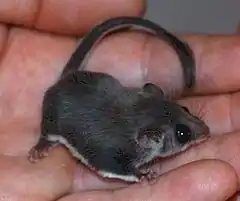| Acrobatidae | |||
| K.P. Aplin, 1987[1] | |||
 Przedstawiciel rodziny – akrobatka karliczka (Acrobates pygmaeus) | |||
| Systematyka | |||
| Domena | |||
|---|---|---|---|
| Królestwo | |||
| Typ | |||
| Podtyp | |||
| Gromada | |||
| Podgromada | |||
| Infragromada | |||
| Nadrząd | |||
| Rząd | |||
| Podrząd | |||
| Nadrodzina | |||
| Rodzina |
akrobatkowate | ||
| Typ nomenklatoryczny | |||
|
Acrobates Desmarest, 1818 | |||
| Synonimy | |||
| |||
| Rodzaje | |||
| |||
Akrobatkowate[3] (Acrobatidae) – rodzina małych, nadrzewnych ssaków z rzędu dwuprzodozębowców (Diprodontia).
Rodzina Acrobatidae została wyodrębniona w 1987 z rodziny drzewnicowatych (Burramyidae). Obejmuje tylko trzy gatunki o niewielkich rozmiarach: 6,5-12 cm długości (bez ogona) i 10-53 g masy ciała. Akrobatka występuje w Australii, a Distoechurus pennatus na Nowej Gwinei[4][5]. Występują na terenach zalesionych, preferują lasy eukaliptusowe. Są zwierzętami nocnymi. Żywią się roślinami, głównie nektarem, a także owadami.
| Wzór zębowy | I | C | P | M | |
|---|---|---|---|---|---|
| 34-36 | = | 3 | 1 | 2-3 | 3 |
| 2 | 0 | 3 | 3 | ||
Podział systematyczny
Do rodziny należą następujące rodzaje[6][7][3]:
- Acrobates Desmarest, 1818 – akrobatka
- Distoechurus W. Peters, 1874 – dziuplówka – jedynym przedstawicielem jest Distoechurus pennatus W. Peters, 1874 – dziuplówka pióroogonowa
Przypisy
- ↑ K.P. Aplin & M. Archer: Recent advances in marsupial systematics with a new syncretic classification. W: M. Archer (red.): Possums and Opossums: Studies in Evolution. Chipping Norton: Surrey Beatty & Sons, 1987, s. xxii, lvii. ISBN 978-0-949324-05-4. (ang.).
- ↑ F.S. Szalay: Evolutionary history of the marsupials and an analysis of osteological characters. Cambridge: Cambridge University Press, 1994, s. 43. DOI: 10.1017/CBO9780511565571. ISBN 978-0-511-56557-1. (ang.).
- 1 2 W. Cichocki, A. Ważna, J. Cichocki, E. Rajska-Jurgiel, A. Jasiński & W. Bogdanowicz: Polskie nazewnictwo ssaków świata. Warszawa: Muzeum i Instytut Zoologii PAN, 2015, s. 14. ISBN 978-83-88147-15-9. (pol. • ang.).
- ↑ K. Aplin: Family Acrobatidae (Feather-tailed Gliders and Feather-tailed Possum). W: D.E. Wilson & R.A. Mittermeier (redaktorzy): Handbook of the Mammals of the World. Cz. 5: Monotremes and Marsupials. Barcelona: Lynx Edicions, 2015, s. 590–591. ISBN 978-84-96553-99-6. (ang.).
- ↑ D.E. Wilson & D.M. Reeder (redaktorzy): Family Acrobatidae. [w:] Mammal Species of the World. A Taxonomic and Geographic Reference (Wyd. 3) [on-line]. Johns Hopkins University Press, 2005. [dostęp 2020-10-26].
- ↑ N. Upham, C. Burgin, J. Widness, M. Becker, C. Parker, S. Liphardt, I. Rochon & D. Huckaby: Treeview of Mammalian Taxonomy Hierarchy. [w:] ASM Mammal Diversity Database (Version 1.11) [on-line]. American Society of Mammalogists. [dostęp 2023-08-06]. (ang.).
- ↑ C.J. Burgin, D.E. Wilson, R.A. Mittermeier, A.B. Rylands, T.E. Lacher & W. Sechrest: Illustrated Checklist of the Mammals of the World. Cz. 1: Monotremata to Rodentia. Barcelona: Lynx Edicions, 2020, s. 90. ISBN 978-84-16728-34-3. (ang.).
Bibliografia
- Myers, P.: Acrobatidae. (On-line), Animal Diversity Web, 2001. [dostęp 2008-04-10]. (ang.).
This article is issued from Wikipedia. The text is licensed under Creative Commons - Attribution - Sharealike. Additional terms may apply for the media files.